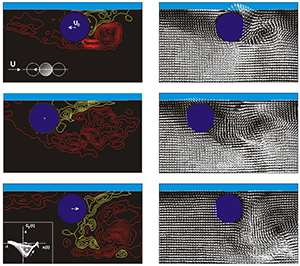You are here
Home ›Streamwise Oscillations of a Cylinder Adjacent to a Free-Surface in Presence of a Steady Current
Streamwise oscillations of a cylinder adjacent to a free-surface in presence of a steady current. Horizontal oscillations of a cylinder adjacent to a free-surface give rise to regions of vorticity emanating from the free-surface at locations upstream of the cylinder, in addition to vorticity layers shed from the surface of the cylinder. The top row of images from the cinema sequence shows dominance of the large-scale positive concentration of vorticity from the lower surface of the cylinder. A region of positive vorticity having large spatial extent is, however, evident upstream of the cylinder. The corresponding velocity image exhibits a zone of low velocity, suggesting occurrence of flow separation from the free-surface. Further development of this pattern is shown in the middle row of images. The large-scale cluster of positive vorticity is due to both that shed from the surface of the cylinder and that originating from the free-surface. The corresponding velocity field indicates a well-defined swirl pattern immediately upstream of the cylinder. In the bottom row of images, the large-scale positive vortex has departed from the cylinder and, simultaneously, the region of negative vorticity has been swept over a relatively large area, extending from the free-surface to well below the cylinder. The incident layer of positive vorticity upstream of the cylinder is now confined to a region immediately adjacent to the free-surface. As indicated in the corresponding velocity image, it is associated with a layer of large velocity defect immediately beneath the surface. As shown in the inset, this interesting process of vorticity field development is associated with positive hysteresis loops on the plane of force coefficient Cy(t) versus cylinder displacement x(t). Amplitude A of the cylinder oscillation relative to the cylinder diameter is A/D = 0.955. Dimensionless steady velocity of current is UT/A = 1.87. Keulegan-Carpenter number is KC = 2pA/D = 6. Reynolds number is Re = 2,058.
A cylinder in a steady current beneath a free-surface is subjected to oscillations in the streamwise direction. Techniques of high-image-density particle image velocimetry and instantaneous force measurement provide the interrelationship between the instantaneous, global flow patterns and the unsteady loading on the cylinder.
The existence of locked-on states for the fully-submerged cylinder is addressed in the companion study of Cetiner and Rockwell (1999). The present investigation shows that it is possible to generate distinctly different locked-on states of vortex formation, provided the cylinder is located immediately beneath the free-surface. As a consequence, the time-dependent transverse force is phase-locked to the cylinder motion. In the event that a finite gap exists between the cylinder and the free-surface, however, instantaneous, jet-like flow through the gap acts to destabilize such locked-on states. Lissajous representations of the forces demonstrate the degree of phase-locking or, in some cases, a loss of lock-on and associated phase drift. Moreover, the degree of submergence of the cylinder beneath the free-surface has remarkable consequences for the magnitudes of positive and negative spikes of the time-dependent force signatures, as well as the averaged spectra of the transverse force. In turn, these alterations of the unsteady transverse force are accompanied by substantial changes of the averaged in-line and transverse forces.
All of these features are related to the instantaneous patterns of vortex formation in the near-wake. During a typical cycle of the cylinder oscillation, these patterns can be synthesized into two broad categories: Kármán-like shedding; and a nearly "frozen" array of shed vortices. The order of occurrence of these basic patterns during an oscillation cycle dictates the instantaneous signatures and time-averaged spectra of the transverse force.

